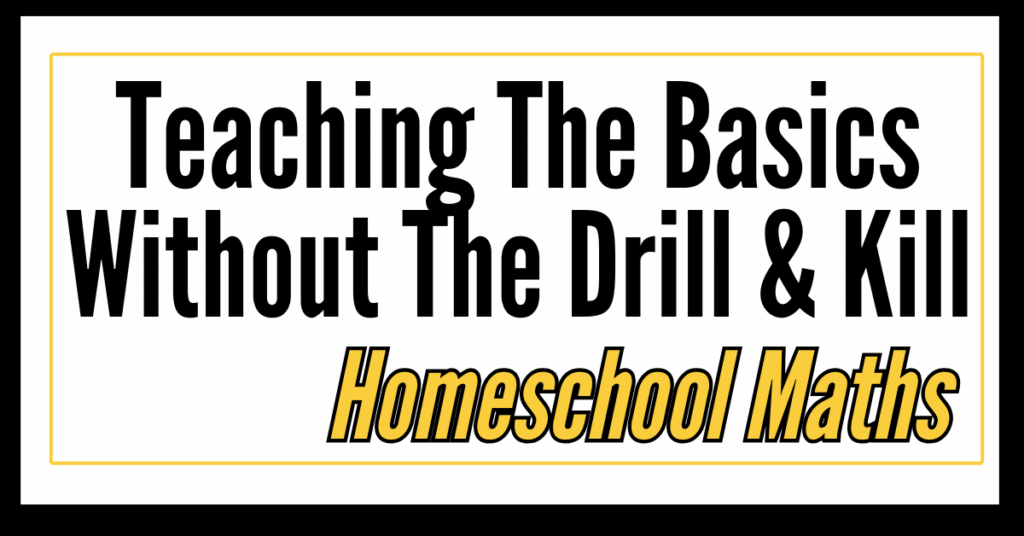
Homeschool Maths – Is There A Better Way Than Rote Learning?
Most long-time homeschoolers are probably aware of the centuries-long debate over reading instruction. You know, the old “whole language vs. synthetic phonics” debate that can rouse the most vehement passions if you accidentally mention it at the wrong dinner party. But far fewer parents are probably aware that there’s just as much debate over maths instruction.
At one extreme, we have the old-school “drill and kill” fraternity, while at the opposite end of the spectrum, we have the modern, de Bono-inspired academicians who disparage any hint of ‘rote’ learning. These academics will tell you that basic calculations don’t need to be taught because they’ve been made obsolete by the computer. They then go on to sagely stress the need for children to learn how to “think mathematically” and develop “higher-order reasoning” or “problem-solving skills.”
The modern emphasis on “real-world” problem-solving skills sounds really good, and it does have its place. Indeed, I would be nothing as an engineer without those very skills. But that leaves us with a burning question: how do we really develop these skills in a child, without the homeschool maths drill & kill? How can we ensure that the mathematics we’re teaching our children will serve them well throughout their adult life, wherever that may lead?
The first thing that you need to understand is that mathematical skills, knowledge and understanding develop progressively. In fact, the whole body of mathematical knowledge can be arranged along one big winding staircase upwards. It winds because the same ideas often do need to be revisited at ever increasing levels of complexity.

What Is Maths? And Why It Needs A Solid Base.
Now a staircase is like any other building in that it needs a good solid foundation in order to stand the test of time and trial. Your child’s future mathematical abilities rely on the foundations you lay at the outset. So the heart of the matter, the one question we need to get to the bottom of, is what is the foundation of mathematics and how do we best teach it to our children?
To answer this we need to ask: what exactly IS mathematics? Now, that’s the sort of question that if you asked 10 experts, you’d likely get 12 answers so, for the sake of simplicity, I will just give you my “working definition”: maths is the study of numbers as applied to analysing the world around us and solving the problems we encounter. There are several branches of mathematics that each deal with different types of descriptions and problems: arithmetic, geometry, algebra and calculus being the main branches.
But unlike other areas of study, it’s not enough to just learn about mathematics. As our definition above implies, for maths to be useful it must be applied. So maths is more than just a study: it is actually both a language and a set of skills and it is this understanding that leads us to the foundation.
Beyond Memorisation – The Secret To Making Maths Click!
Since maths is a language, it must have an alphabet, and indeed it does. The mathematical alphabet consists of various symbols but at the beginning we only need to know 15 of them: the digits 0-9 and the common symbols we use for the basic operations: +, -, ×, ÷ and =. This small and simple alphabet is the foundation of the whole body of mathematics and its study is enough to keep a child occupied for several years but not necessarily in the way you might imagine.
This beginning alphabet introduces the most fundamental branch of mathematics: arithmetic. Arithmetic comes from a Greek word that literally means to count. It’s easy to understand that the digits 0-9 are involved with counting. After all, counting without numbers is, well, nothing. But did you realise that the operations described by the symbols +, -, × and ÷ are also just sophisticated ways of counting? Adding and multiplying are just shortcuts for counting up and subtracting and dividing are just shortcuts for counting down. A child who is unable to automatically add, subtract, multiply and divide with single digits is likely to be as lost in mathematics as the child who can’t count at all.

So does that mean the “drill and kill” fraternity had it right? Well, maybe on the surface but there are two fundamental problems with a “rote” method of learning the tables. The first is that many children will disengage very quickly when a “passive” rote method is used (think chanting tables or copying them out). Once the child is disengaged, the second problem usually surfaces: the child does not notice the patterns and relationships between the numbers and operations which make maths ‘click.’
So the secret to mathematical mastery is to begin by teaching children how to count thoroughly and then reveal to them the many varied and fascinating patterns that are hiding in plain sight on the number line. That requires a lot of hands-on, mind-on practice on the part of the child. At Milestone Maths we aim to give children these foundational insights and experiences.
Thanks to Kathy from Milestone Maths for sharing this insight with our community. To find out more about Milestone Maths, see their detailed listing in our Homeschool Resource Directory

